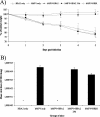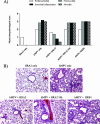Identification and evaluation of a highly effective fusion inhibitor for human metapneumovirus
- PMID: 17967906
- PMCID: PMC2223880
- DOI: 10.1128/AAC.00793-07
Identification and evaluation of a highly effective fusion inhibitor for human metapneumovirus
Abstract
Human metapneumovirus (hMPV) can cause acute upper and lower respiratory tract infections that are particularly severe in young children, elderly subjects, and immunocompromised patients. To date, no treatments or vaccines are available for hMPV infections. Our objective was to assess the inhibitory potential of several peptides derived from the heptad repeat A and B (HRA and HRB) domains of the hMPV fusion protein. Nine candidate peptides were expressed in Escherichia coli or obtained synthetically and tested in vitro and in an animal model. Excellent in vitro inhibition of an hMPV strain of the A1 subgroup was obtained with five peptides, with 50% inhibitory concentrations ranging from 1.4 nM to 3.3 microM. One peptide, HRA2, displayed very potent activity against all four hMPV subgroups. It was also moderately active against human respiratory syncytial virus (strain A2) but displayed no activity against human parainfluenza virus type 3. BALB/c mice that received the HRA2 peptide and a lethal hMPV intranasal challenge simultaneously were completely protected from clinical symptoms and mortality. On day 5 postinfection, HRA2-treated mice had undetectable lung viral loads which were significantly less than those of untreated mice (3 x 10(4) 50% tissue culture infective doses/lung). Pulmonary inflammation, levels of proinflammatory cytokines/chemokines (RANTES, gamma interferon, and monocyte chemoattractant protein 1) and airway obstruction were also significantly decreased in HRA2-treated mice. The results of this study demonstrate that potent antivirals can be derived from the hMPV fusion protein HR domains. Moreover, hMPV, compared to other paramyxoviruses and to the human immunodeficiency virus, seems to be more susceptible to HRA- than HRB-derived peptides.
Figures





Similar articles
-
HRA2pl peptide: a fusion inhibitor for human metapneumovirus produced in tobacco plants by transient transformation.Planta. 2015 Jul;242(1):69-76. doi: 10.1007/s00425-015-2277-5. Epub 2015 Apr 1. Planta. 2015. PMID: 25828350
-
Inhibition of Human Metapneumovirus Binding to Heparan Sulfate Blocks Infection in Human Lung Cells and Airway Tissues.J Virol. 2016 Sep 29;90(20):9237-50. doi: 10.1128/JVI.01362-16. Print 2016 Oct 15. J Virol. 2016. PMID: 27489270 Free PMC article.
-
Examination of a fusogenic hexameric core from human metapneumovirus and identification of a potent synthetic peptide inhibitor from the heptad repeat 1 region.J Virol. 2007 Jan;81(1):141-9. doi: 10.1128/JVI.01243-06. Epub 2006 Oct 11. J Virol. 2007. PMID: 17035305 Free PMC article.
-
An overview of progress in human metapneumovirus (hMPV) research: Structure, function, and therapeutic opportunities.Drug Discov Today. 2025 May;30(5):104364. doi: 10.1016/j.drudis.2025.104364. Epub 2025 Apr 24. Drug Discov Today. 2025. PMID: 40286981 Review.
-
Ten years of human metapneumovirus research.J Clin Virol. 2012 Feb;53(2):97-105. doi: 10.1016/j.jcv.2011.10.002. Epub 2011 Nov 9. J Clin Virol. 2012. PMID: 22074934 Review.
Cited by
-
HRA2pl peptide: a fusion inhibitor for human metapneumovirus produced in tobacco plants by transient transformation.Planta. 2015 Jul;242(1):69-76. doi: 10.1007/s00425-015-2277-5. Epub 2015 Apr 1. Planta. 2015. PMID: 25828350
-
Metapneumovirus Infections and Respiratory Complications.Semin Respir Crit Care Med. 2016 Aug;37(4):512-21. doi: 10.1055/s-0036-1584800. Epub 2016 Aug 3. Semin Respir Crit Care Med. 2016. PMID: 27486733 Free PMC article. Review.
-
Antiviral therapy for respiratory viral infections in immunocompromised patients.Expert Rev Anti Infect Ther. 2017 Apr;15(4):401-415. doi: 10.1080/14787210.2017.1279970. Epub 2017 Jan 16. Expert Rev Anti Infect Ther. 2017. PMID: 28067078 Free PMC article. Review.
-
Update in Viral Infections in the Intensive Care Unit.Front Med (Lausanne). 2021 Feb 23;8:575580. doi: 10.3389/fmed.2021.575580. eCollection 2021. Front Med (Lausanne). 2021. PMID: 33708775 Free PMC article. Review.
-
Respiratory Infections in the U.S. Military: Recent Experience and Control.Clin Microbiol Rev. 2015 Jul;28(3):743-800. doi: 10.1128/CMR.00039-14. Clin Microbiol Rev. 2015. PMID: 26085551 Free PMC article. Review.
References
-
- Boivin, G., Y. Abed, G. Pelletier, L. Ruel, D. Moisan, S. Cote, T. C. Peret, D. D. Erdman, and L. J. Anderson. 2002. Virological features and clinical manifestations associated with human metapneumovirus: a new paramyxovirus responsible for acute respiratory-tract infections in all age groups. J. Infect. Dis. 186:1330-1334. - PubMed
-
- Boivin, G., G. De Serres, M. E. Hamelin, S. Cote, M. Argouin, G. Tremblay, R. Maranda-Aubut, C. Sauvageau, M. Ouakki, N. Boulianne, and C. Couture. 2007. An outbreak of severe respiratory tract infection due to human metapneumovirus in a long-term care facility. Clin. Infect. Dis. 44:1152-1158. - PubMed
-
- Branden, C., and J. Tooze. 1999. Introduction to protein structure, 2nd ed., p. 14-46. Garland Publishing, New York, NY.
Publication types
MeSH terms
Substances
LinkOut - more resources
Full Text Sources
Research Materials

